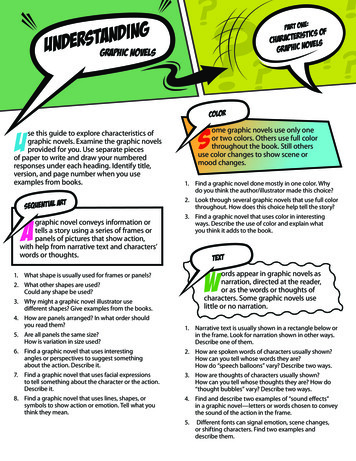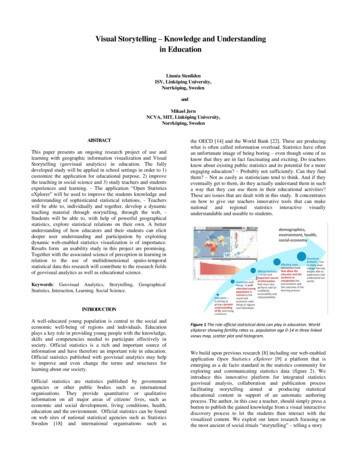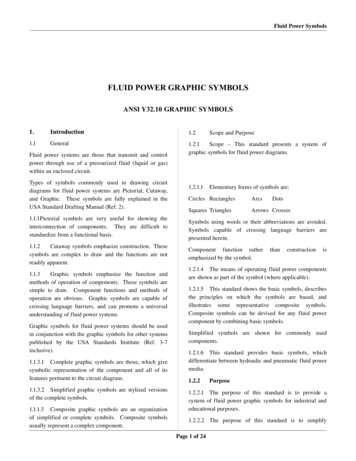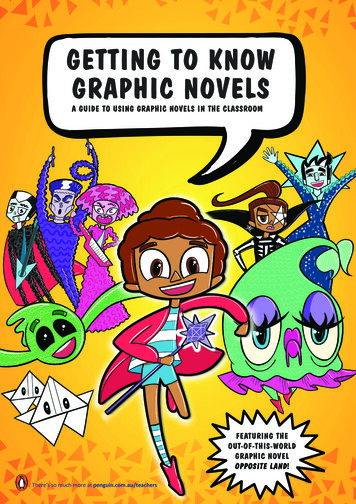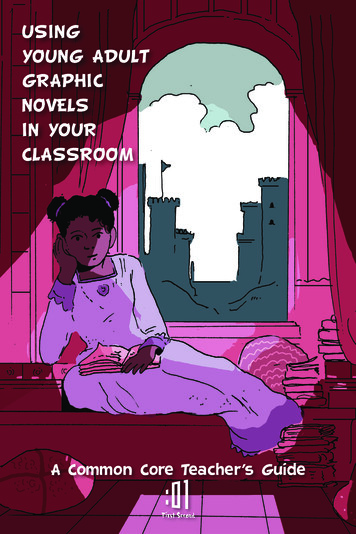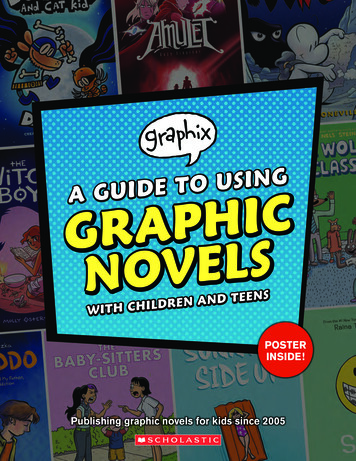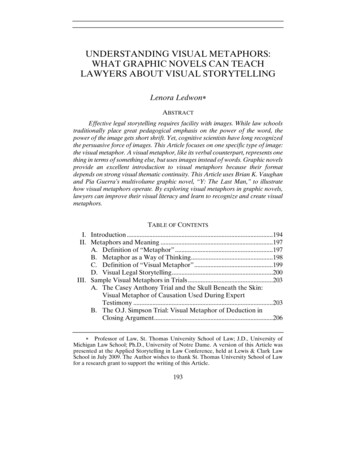
Transcription
UNDERSTANDING VISUAL METAPHORS:WHAT GRAPHIC NOVELS CAN TEACHLAWYERS ABOUT VISUAL STORYTELLINGLenora Ledwon ABSTRACTEffective legal storytelling requires facility with images. While law schoolstraditionally place great pedagogical emphasis on the power of the word, thepower of the image gets short shrift. Yet, cognitive scientists have long recognizedthe persuasive force of images. This Article focuses on one specific type of image:the visual metaphor. A visual metaphor, like its verbal counterpart, represents onething in terms of something else, but uses images instead of words. Graphic novelsprovide an excellent introduction to visual metaphors because their formatdepends on strong visual thematic continuity. This Article uses Brian K. Vaughanand Pia Guerra’s multivolume graphic novel, “Y: The Last Man,” to illustratehow visual metaphors operate. By exploring visual metaphors in graphic novels,lawyers can improve their visual literacy and learn to recognize and create visualmetaphors.TABLE OF CONTENTSI. Introduction .194II. Metaphors and Meaning .197A. Definition of “Metaphor” .197B. Metaphor as a Way of Thinking .198C. Definition of “Visual Metaphor” .199D. Visual Legal Storytelling .200III. Sample Visual Metaphors in Trials .203A. The Casey Anthony Trial and the Skull Beneath the Skin:Visual Metaphor of Causation Used During ExpertTestimony .203B. The O.J. Simpson Trial: Visual Metaphor of Deduction inClosing Argument .206 Professor of Law, St. Thomas University School of Law; J.D., University ofMichigan Law School; Ph.D., University of Notre Dame. A version of this Article waspresented at the Applied Storytelling in Law Conference, held at Lewis & Clark LawSchool in July 2009. The Author wishes to thank St. Thomas University School of Lawfor a research grant to support the writing of this Article.193
194Drake Law Review[Vol. 63C. The Vioxx Case: Empty Space and Visual Metaphors ofLoss in Opening Statement .208IV. Graphic Novels .211A. Definition of “Graphic Novel” .212B. Graphic Novels and Legal Culture .213C. Visual Metaphors and Graphic Novels .213V. Reading for Visual Metaphors in Y: The Last Man .215A. The Suspended Man as a Visual Metaphor .217B. Images of Y as Visual Metaphors .220C. The “Alas, Poor Yorick” Pose as a Visual Metaphor .222D. Combining All Three Visual Themes: The Final Volume .2271. The Suspended Man .2282. The Y Visual .2283. The “Alas, Poor Yorick” Visual .229E. The Triple-Visual Metaphor.230VI. Some Concluding Suggestions for Improving Visual Storytelling .233A. Further Reading for Visual Metaphors: Ten Graphic NovelsYou Should Read .233B. Exercise in Creating Visual Metaphors .236I. INTRODUCTIONDuring the 2008 presidential election, a powerful image circulated inthe media: an illustration of presidential candidate Barack Obama asSuperman.1 In the illustration, titled Time for a Change, Obama is dressed ina suit and tie and stands in the iconic pose of Clark Kent changing intoSuperman. He is ripping open his shirt to reveal a superhero costumeunderneath, but instead of an S for Superman, his costume features a largeO for Obama. The image references both Obama’s campaign slogan,“Change,” and the changing-clothes/changing-identities moment inSuperman comic books when the mild-mannered Clark Kent transforms into1. The image, created by Alex Ross, can most easily be found by doing a Googleimage search for “Alex Ross Obama.” Alternatively, it is available at Ross’s officialwebsite, http://www.alexrossart.com/rossreport.asp?id 430. An archived version of theoriginal image is available at http://i.imgur.com/qrqUHg1.jpg. A photo of then-candidateObama holding up a t-shirt with this image on it is available at Ross’s official website.Obama Sports Alex Ross T-Shirt, ALEX ROSS ART (Oct. 31, 2008), http://www.alexrossart.com/rossreport.asp?id 466.
2015]Understanding Visual Metaphors195a superhero.2 This single image tells a resonant story about a seeminglyordinary man who has extraordinary abilities and it taps into ourpsychological desire for a hero or savior to help in troubled times. It alsodaringly addresses the subtext of race in the election by portraying the mostAmerican of superheroes, Superman, as a black man. This artwork, createdby well-known comic book and graphic novel illustrator Alex Ross,3 is avisual metaphor. It is no coincidence that this powerful image is rooted inthe world of graphic novels because graphic novels are replete with visualmetaphors, and the genre itself is characterized by visual storytelling.Lawyers can learn a great deal from the visual storytelling in such images.Specifically, this Article suggests that lawyers can improve their visualliteracy and become better visual storytellers by studying graphic novels.Successful litigators need to be visually literate. A surge of recent legalscholarship demonstrates the importance of this issue.4 Effective legal2. Even in the very first issue of Action Comics in 1938, Superman was depictedremoving his white dress shirt to reveal the S logo emblazoned on his chest and assuminghis superhero identity. See, e.g., Jerome Siegel & Jerry Shuster, Superman, ACTIONCOMICS 1, at 1–13 (DC Comics June 1938), reprinted in JERRY SIEGEL & JOE SHUSTER,1 SUPERMAN ARCHIVES 11 (1989).3. Alex Ross illustrated Marvels (KURT BUSIEK & ALEX ROSS, MARVELS (Marvel1994)), Kingdom Come (MARK WARD & ALEX ROSS, KINGDOM COME (DC Comics1996)), and Uncle Sam (STEVE DARNALL & ALEX ROSS, UNCLE SAM (Vertigo 1997)),among other notable works. See Alex Ross Biography, ALEX ROSS ART, http://www.alexrossart.com/bio.asp.4. For a representative sampling of the excellent work being done on this issue,see the following: NEAL FEIGENSON & CHRISTINA SPIESEL, LAW ON DISPLAY: THEDIGITAL TRANSFORMATION OF LEGAL PERSUASION AND JUDGMENT (2009) (presentingan in-depth, sophisticated analysis of the new pictorial and visual skills lawyers mustmaster in the twenty-first century, with analysis of specific trials); Fred Galves, Wherethe Not-So-Wild Things Are: Computers in the Courtroom, the Federal Rules of Evidence,and the Need for Institutional Reform and More Judicial Acceptance, 13 HARV. J.L. &TECH. 161, 165 (2000) (arguing that lawyers and courts should adapt to the progressbeing made in technological communication by allowing the use of “computer generatedexhibits,” including animations, as visual aids); Gregory J. Morse, Techno-Jury:Techniques in Verbal and Visual Persuasion, 54 N.Y.L. SCH. L. REV. 241, 247–58 (2010)(discussing the use of visual persuasion technology in courtroom litigation); Richard K.Sherwin, A Manifesto For Visual Legal Realism, 40 LOY. L.A. L. REV. 719, 724–36 (2007)[hereinafter Sherwin, Manifesto] (making the case for a “new visual legal realism” tomatch current technology with meaning-making in the law and encouraging attorneys touse visual imagery that “exploit[s] the iconic” and “emulate[s] generic fictions” tocommunicate ideas holistically (internal quotation marks omitted)); Richard K. Sherwin,Visual Jurisprudence, 56 N.Y.L. SCH. L. REV. 137, 140 (2013) (“New critical standards areneeded to help jurists cope with the epistemological, ontological, and metaphysical
196Drake Law Review[Vol. 63storytelling requires not only facility with words, but also facility withimages. Because law schools traditionally place all their pedagogicalemphasis on the power of the word, the power of the image receives littleattention. Yet, cognitive scientists have long recognized the power ofimages.5 This Article focuses on one specific type of image: the visualmetaphor. A visual metaphor, like its verbal counterpart, represents onething in terms of something else, but uses an image instead of words—likethe Obama-as-Superman image. Visual metaphors in graphic novels (and intrials) are superb storytelling devices because they capture an audience’sattention and provide thematic continuity over the course of a lengthystoryline.6 By analyzing examples of visual metaphors in graphic novels,lawyers can improve their visual literacy and learn to recognize, and evencreate, visual metaphors.This Article will first present pertinent background information bydefining key terms and summarizing recent studies on the importance ofvisual storytelling for lawyers.7 Second, this Article will analyze specificquandaries that accompany law’s migration to the screen.”); Joel Simberg, DisplayingDigital Media During Opening Statements: Tactics, Techniques, and Pitfalls, 60 DEPAULL. REV. 789 (2011) (discussing discovery, evidence, and strategic issues concerning theuse of technology and visual aids during opening statements); Christina O. Spiesel,Richard K. Sherwin & Neal Feigenson, Law in the Age of Images: The Challenge ofVisual Imagery, in CONTEMPORARY ISSUES OF THE SEMIOTICS OF LAW 231 (A. Wagneret al. eds., 2005) (arguing that law should follow the lessons of journalism, politics, andadvertising in incorporating visual rhetoric).5. We retain information from images longer and more fully than informationfrom words alone.Scientists tell us that after three days, we remember only 10 percent ofmaterial that is presented verbally and 20 percent of what is presented visually.But when a verbal presentation is combined with a visual one, we remember 65percent of the material. These statistics bring home the importance of usingdemonstrative evidence and visual aids at trial.Jim M. Perdue Sr. & Jim M. Perdue Jr., Grand Openings, TRIAL, May 2010, at 46, 49(citing Noelle Nelson, Maximizing Your Opening Statement’s Impact, LAWDRAGON(Apr. 2009), pening%20statement%204-09.pdf).6. See Sherwin, Manifesto, supra note 4, at 731 (providing examples of visualmetaphors that “simplify the complex” and discussing “the immediate and enduringimpact that this kind of visual persuasion exerts on decision makers’ thinking andjudgment” by making a “theory of the case immediately accessible to ordinary commonsense” (emphasis removed) (internal quotation marks omitted)).7. See infra Part II.
2015]Understanding Visual Metaphors197visual metaphors used in three real-life trials (the Casey Anthony trial, theO.J. Simpson trial, and the Vioxx trial) that visually conceptualize themessuch as causation, guilt, loss, and justice.8 Third, this Article will discuss howreading graphic novels can help lawyers become better visual storytellers byanalyzing thematic uses of visual metaphors in Brian K. Vaughan and PiaGuerra’s award-winning, multivolume graphic novel, Y: The Last Man.9 ThisArticle will conclude with further suggestions for recognizing visualmetaphors (including a list of graphic novels suggested for in-depth analysis)and suggestions for an exercise in creating visual metaphors.10II. METAPHORS AND MEANINGA. Definition of “Metaphor”According to the Oxford English Dictionary, a metaphor is primarily averbal device, a type of speech act “in which a name or descriptive word orphrase is transferred to an object or action different from, but analogous to,that to which it is literally applicable.”11 In other words, a metaphor is “theuse of language to refer to something other than what it was originallyapplied to, or what it ‘literally’ means, in order to suggest some resemblanceor make a connection between the two things.”12Traditional analysis of verbal metaphor divides a metaphor into threeparts: the “vehicle,” the word or phrase that is the metaphor; the “topic” or“tenor,” the intended meaning that the word or phrase represents; and the“grounds,” the connection between the two.13 So, for example, themetaphorical phrase, “a mountain of paperwork,” consists of the vehicle(mountain), the tenor/topic (a large amount), and the grounds (ideas of size,immovability, and difficulty).14 An alternative two-part terminologysometimes is used when analyzing “conceptual metaphors” that relate two8.9.10.11.See infra Part III.See infra Part IV–V.See infra Part VI.Metaphor Definition, OED.COM, http://www.oed.com/view/Entry/117328 (lastvisited Nov. 17, 2014). The Oxford English Dictionary’s secondary definition of“metaphor” is “[s]omething regarded as representative or suggestive of something else,esp[ecially] as a material emblem of an abstract quality, condition, notion, etc.; a symbol,a token.” Id.12. MURRAY KNOWLES & ROSAMUND MOON, INTRODUCING METAPHOR 3 (2006).13. Id. at 9–10.14. Id. at 9.
198Drake Law Review[Vol. 63abstract concepts: a “source domain” from which the metaphor is drawn anda “target domain” to which the metaphor is applied.15 Thus, for example, inthe conceptual metaphor “argument is war,” “war” is the source domain and“argument” is the target domain.16B. Metaphor as a Way of ThinkingMetaphors are much more than just literary flourishes to embellishspeech; they are essential cognitive tools.17 As George Lakoff and MarkJohnson note, “[M]etaphor is pervasive in everyday life, not just in languagebut in thought and action. Our ordinary conceptual system, in terms of whichwe both think and act, is fundamentally metaphorical in nature.”18 Thus,metaphor is a framework for “understanding and experiencing one kind ofthing in terms of another.”19 Metaphors are essential to cognition because ametaphor helps people understand something new or unfamiliar byconnecting it to something familiar.In the field of law, metaphors can help lawyers understand new legalconcepts by drawing on their understanding of more familiar concepts.20Metaphors can be particularly helpful in understanding abstract legalconcepts that may be difficult to describe, such as justice, reasonable doubt,guilt, and the like. Justice Benjamin Cardozo commented (somewhatdisingenuously) that metaphors might be too dangerously powerful as legaltools: “Metaphors in law are to be narrowly watched, for starting as devicesto liberate thought, they end often by enslaving it.”21 This, of course, did not15. Id. at 33.16. Id.17. “Metaphor is not simply an ornamental aspect of language, but a fundamentalscheme by which people conceptualize the world and their own activities.” Raymond W.Gibbs, Jr., Metaphor and Thought: The State of the Art, in THE CAMBRIDGE HANDBOOKOF METAPHOR AND THOUGHT 3, 3 (Raymond W. Gibbs, Jr. ed., 2008).18. GEORGE LAKOFF & MARK JOHNSON, METAPHORS WE LIVE BY 3 (1980).19. Id. at 5 (emphasis removed); see also KNOWLES & MOON, supra note 12, at 31(discussing metaphor as “a kind of thinking or conceptualization, not limited tolanguage”).20. For example, describing the Internet as “cyberspace” was a metaphor forsomething new to legal practitioners that suggested an actual physical environment withthe attendant boundaries and ownership issues from the familiar area of real propertylaw. See Stuart J. Kaplan, Let Me Hear Your Web Sights: Visual and Aural Metaphors forthe Internet, 40 IDAHO L. REV. 299, 304–05 (2004) (quoting Mark A. Lemley, Place andCyberspace, 91 CALIF. L. REV. 521, 522 (2003)).21. Berkey v. Third Ave. Ry. Co., 155 N.E. 58, 61 (N.Y. 1926). Note that, even while
2015]Understanding Visual Metaphors199prevent Justice Cardozo from using metaphors frequently in his manymemorable opinions.22C. Definition of “Visual Metaphor”While we traditionally understand metaphor as a verbal device, it canalso operate visually. This makes sense if we understand metaphor as both acommunicative tool and a kind of cognitive process that can operate inlinguistic modes, pictorial modes, or both.23 A visual metaphor functions thesame as a verbal metaphor, but with images. A good working definition ofvisual metaphor is “[t]he representation of a person, place, thing, or idea byway of a visual image that suggests a particular association or point ofsimilarity.”24 In a purely visual metaphor, the target and source domains arepresented visually, rather than verbally.25 Consider, for example, theObama-as-Superman visual metaphor.26 The presidential candidate iscompared to the superhero by way of mapping the features of the sourcedomain—the character of Superman—onto the target domain—presidentialcandidate Barack Obama. “Reading” the image requires that we paycautioning against reliance on metaphors, this phrase uses two related metaphors todescribe their potential impacts on the conceptualization and application of law.22. For an excellent analysis of Justice Cardozo’s storytelling, including his use ofmetaphors such as “quicksands [of property law]” and “a maze of contradictions,” seeRICHARD WEISBERG, POETHICS: AND OTHER STRATEGIES OF LAW AND LITERATURE6–7, 12–20 (1992) (internal quotation marks omitted).23. As Hermine Feinstein states: “The differences between linguistic and visualmetaphor notwithstanding, the basic definition of metaphor obtains for both—thetransfer of attributes by comparison, by substitution, or as a consequence of interaction.”Hermine Feinstein, Meaning and Visual Metaphor, 23 STUD. ART EDUC., No. 2, Feb.1982, at 45, 50.24. Richard Nordquist, Visual Metaphor, ABOUT EDUC. http://grammar.about.com/od/tz/g/vismeterm.htm (last visited Nov. 9, 2014). This is a suitable workingdefinition for this Article’s purposes, but it is far from comprehensive. “To understandvisual metaphor is a difficult task; to explain it is more difficult. For how can one beginto do justice verbally to that which is by nature nonverbal and visual?” Feinstein, supranote 23, at 47.25. As Charles Forceville notes, “Pictorial metaphor (or visual metaphor) is themost examined nonverbal mode of metaphor, although as yet no unified theory exists.Pictorial metaphors are monomodal: their target and source are entirely rendered invisual terms, just as their verbal sisters have a target and source entirely rendered inlanguage.” Charles Forceville, Metaphor in Pictures and Multimodal Representations, inTHE CAMBRIDGE HANDBOOK OF METAPHOR AND THOUGHT, supra note 17, at 462, 464(citations omitted).26. See discussion supra text accompanying notes 1–2.
200Drake Law Review[Vol. 63attention to how signs and symbols carry meaning.27 This requires a certainlevel of proficiency on the reader’s part. High school teachers and collegeprofessors understand that today’s successful students must be visuallyliterate; that is, capable of decoding and critically evaluating visualmessages.28 Similarly, legal educators should understand that visual literacyis a crucial skill for twenty-first-century lawyering.29D. Visual Legal StorytellingLawyers are wordsmiths, and words are the tools of the legal trade. Butwe would be wise to remember the potential of images as tools, as well as27. For a sampling of some of the recent scholarship on visual pedagogy, visualrhetoric, and visual argument, see VISUAL RHETORIC IN A DIGITAL WORLD: A CRITICALSOURCEBOOK (Carolyn Handa ed., 2004).28. See Mary Burns & Danny Martinez, Visual Imagery and the Art of Persuasion,LEARNING & LEADING WITH TECH., Mar. 2002, at 32, 33 (“[T]o navigate 21st-centurymass culture, [students] must also be visually literate—able to decode, comprehend, andanalyze the elements, messages, and values communicated by images, particularly inadvertising.”); James Bucky Carter, Introduction—Carving a Niche: Graphic Novels inthe English Language Arts Classroom, in BUILDING LITERACY CONNECTIONS WITHGRAPHIC NOVELS: PAGE BY PAGE, PANEL BY PANEL 1, 3–12 (James Bucky Carter ed.,2007) (discussing both empirical research on visual literacy and the National Council ofTeachers of English’s statements on the importance of multimodal literacies as supportfor the idea that “visual literacy, cultural literacy, and critical literacy have become moreand more intertwined”).29. Richard K. Sherwin comments:No modern courtroom lacks for electronic monitors, and most come equippedwith platforms for visual projection. Of course, whether lawyers and judgescome into court adequately trained in the craft of producing and crossexamining, or making informed rulings on the admissibility of visual evidence,or the propriety of visual arguments, is another matter altogether. How long lawschools will persist in the pretense that law remains exclusively a matter ofwords, . . . only time will tell. But the longer this ostrich-like behavior continueswithin the halls of legal academia, the further legal training will retreat from thepractical realities of legal practice.Sherwin, Manifesto, supra note 4, at 724–25 (footnote omitted); see also David S. Birdsell& Leo Groarke, Toward a Theory of Visual Argument, ARGUMENTATION AND ADVOC.,Summer 1996, at 1, reprinted in VISUAL RHETORIC IN A DIGITAL WORLD, supra note 27,at 309 (“[A]rgumentation theorists do not pay enough attention to the visualcomponents of argument and persuasion.”). Sherwin practices what he preaches, as heis the founder and director of New York Law School’s Visual Persuasion Project,dedicated to helping lawyers become better visual communicators. See Visual PersuasionProject, N.Y. LAW SCH., http://www.visualpersuasionproject.com (last visited Nov. 9,2014).
2015]Understanding Visual Metaphors201the communicative power of words combined with images. The old sayingthat “a picture is worth a thousand words” turns out to be true, particularlywhen it comes to persuasive storytelling at trial.30 Visual information assistsjuries in a number of ways “that are extremely useful, if not essential”: ithelps make difficult concepts imaginable by prompting sensory imagery withconcrete depictions rather than abstract ideas; it tightens the proximitybetween the information and the jury by decreasing the number of mentalsteps the jury must take to convert information to an understandable form;and it promotes recall by using memory-encoding pathways that are moreeffective than the pathways that encode memories of words alone.31 Further,combining images with words may have an exponential effect on a juror’sability to remember information.32 Cognitive science indicates that ifinformation is coded redundantly—with both words and images—people aremore likely to remember that information.33 Finally, in addition to aidingmemory, images can improve comprehension.34 Thus, images have some30. The idea of images having rhetorical power is not new to the digital age. KevinLaGrandeur traces the theoretical basis for using images as forms of persuasion back tothe classical rhetorical traditions of Aristotle, Gorgias, and Horace. Kevin LaGrandeur,Digital Images and Classical Persuasion, in ELOQUENT IMAGES: WORD AND IMAGE INTHE AGE OF NEW MEDIA 117, 119–24 (Mary E. Hocks & Michelle R. Kendrick eds.,2003) [hereinafter ELOQUENT IMAGES]. But cf. Feinstein, supra note 23 (maintainingthat “[a] picture is not worth a thousand words, or any other number” because verbalmetaphors and visual metaphors construct and convey meaning differently, andtherefore “[w]ords are the wrong currency to exchange for a picture” (quoting DONALDDAVIDSON, ON METAPHOR 45 (1979) (internal quotation marks omitted))).31. Galves, supra note 4, at 188–89 (citing RICHARD NISBITT & LEE ROSS, HUMANINFERENCE: STRATEGIES AND SHORTCOMINGS OF SOCIAL JUDGMENT 47, 51 (1980)).32. Feigenson and Spiesel note, “People learn better when information is presentedpictorially (the mode corresponding to the visual channel) as well as verbally, becausewhen both pictures and words are presented, people can construct mental models of theinformation in both their visual and their verbal channels and build connections betweenthem.” FEIGENSON & SPIESEL, supra note 4, at 77.33. Jennifer Wiley, Cognitive and Educational Implications of Visually Rich Media:Images and Imagination, in ELOQUENT IMAGES, supra note 30, at 201, 203–04 (citingALAN PAIVIO, MENTAL REPRESENTATIONS: A DUAL CODING APPROACH (1986); JamesClark & Alan Paivio, Dual Coding Theory and Education, 3 EDUC. PSYCHOL. REV. 149(1991)).34. See id. at 204–05 (citing Darrell Butler, Graphics in Psychology, 25 BEHAV.,RES. METHODS, INSTRUMENTS & COMPUTERS 81 (1993); William Winn, Recall of thePattern, Sequence, and Names of Concepts Presented in Instructional Diagrams, 25 J. RES.SCI. TEACHING 375 (1988)) (noting that “figures, graphs, or flowcharts that may enablethe reader to think about abstract concepts through images may allow for the creationof more complete situation models and as a consequence may in fact improve
202Drake Law Review[Vol. 63advantages over words, and because graphic novels tell stories with bothimages and words, they are excellent vehicles for storytelling analysis.Litigators have long recognized the importance of using visuals attrial.35 Use of visuals must, of course, comply with evidentiary rules requiringrelevance and safeguarding against undue prejudice, as well as rulesconcerning the admissibility of the underlying evidence that the visualmaterial references.36 Although we know that lawyers utilize visualmetaphors, examples are still a bit hard to find because popular legaldatabases such as Lexis or Westlaw do not typically include trial exhibits anddo not properly display graphical content.37 As a practical matter, it is muchcomprehension”).35. See, e.g., Mark W. Klingensmith, Opening Statement, in FLA. CIVIL TRIALPRACTICE § 8.25, at 8–31 (9th ed. 2012) (“Therefore, to the extent permitted by the court,some form of demonstrative or audiovisual aid should be considered for almost everyopening statement, even if it is created on the spot using poster board and a magicmarker.”); Perdue & Perdue, supra note 5, at 49 (“Every case has one or two visualimages that convey its meaning. Once you determine what those images are, you candisplay them to the jury through digital means such as a PowerPoint presentation orsimply use a document projector during opening statement.”).36. Generally, all evidence should be relevant and not unfairly prejudicial. See FED.R. EVID. 401, 403. There is scarce guidance for courts and litigators on how to assess therelevance and the potential prejudicial impact of visual aids. See generally Morse, supranote 4, at 255–57 (discussing the application of Federal Rule of Evidence 403, whichinstructs courts to exclude evidence that is determined to be unduly prejudicial, inseveral cases where parties used PowerPoint presentations with drawings and text);Simberg, supra note 4, at 790–94 (noting that courts have considerable latitude as far asallowing visual digital media during opening statements and suggesting the safestapproach is to be forthcoming with the judge and opposing counsel in advance); BruceH. Stern, Use of PowerPoint in Opening Statement, 1 ANN.2007 AAJ-CLE 789 (2007)(commenting that the use of PowerPoint slides with pictures or documents can be acomplex issue, recommending resolving those issues at an evidentiary hearing beforetrial, and providing a sample brief asserting the right to use PowerPoint and otherdemonstrative evidence in opening statements).37. The rarity of readily available examples notwithstanding, effective trial lawyersunderstand the importance of using visual metaphors. For example, Gregory Morseexplains how he would incorporate a visual metaphor into an opening statement asfollows:To illustrate the concept of reasonable doubt to a jury, I used to explain that theprosecutor’s case is like a balloon, and to find my client guilty, the balloon wouldhave to fly. While I explained this, I would draw a balloon on an easel in frontof the jury. I would also explain that every aspect of reasonable doubt in theprosecutor’s case is like a hole in the balloon. I would then add a hole in theballoon for every piece of evidence that created reasonable doubt by its absence
2015]Understanding Visual Metaphors203easier to study appellate cases than trial proceedings, because it is easier toresearch and access appellate materials online and in law libraries. This isyet another reason to consider using readily available sources, such asgraphic novels, to explore visual metaphors. However, on occasion, highprofile trials will generate so much public interest that the media will provideextensive coverage, including photographs or videos of trial exhibits.38Following are three examples of visual metaphors used in high-profile trials.As demonstrated in the discussion of graphic novels, infra, these three visualmetaphors are structurally very similar to the type of sequential art used ingraphic novels and comic books, in that they are individual images that are“read” in a particular sequence to tell a particular story.III. SAMPLE VISUAL METAPHORS IN TRIALSA. The Casey Anthony Trial and the Skull Beneath the Skin: VisualMetaphor of Causation Used During Expert TestimonyDuring the highly publicized Casey Anthony trial, in which thedefendant was accused of killing her young daughter Caylee, theprosecution int
UNDERSTANDING VISUAL METAPHORS: WHAT GRAPHIC NOVELS CAN TEACH LAWYERS ABOUT VISUAL STORYTELLING Lenora Ledwon ABSTRACT Effective legal storytelling requires facility with images. While law schools traditionally place great pedagogical emphasis on the pow
